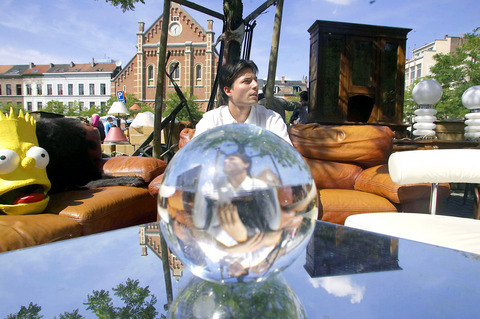On the surface, Brussels, Belgium, seems fairly boring: It is clean and the headquarters of the European Community, and has a lot of restaurants uniformly serving artery-clogging moules-frites and beer. But the interior designers and vintage-furniture aficionados, who routinely trek in from Europe's more fashionable capitals nearby, know better.
Brussels' cobblestone streets and Flemish row houses south of the city center are teeming with eclectic second-hand finds -- from medieval swords to 1980 chrome -- at bargain prices. In a morning's stroll, it's possible to happen upon African tribal masks, Art Deco Rolexes from the 1920s and Lucite coffee tables that look right out of Halston's Studio 54-era town house.
"It's like Paris was 30 years ago," said Alix Everaert, who runs Designaddict.com, a design industry database based in Brussels. "Belgium is still cheap in comparison to the rest of Europe, so you can find good deals. It's like shopping in a little village, except the mentality is multicultural." The best time to hunt, gather or pick is weekend mornings, when the Sablon Antiques Market in Place du Grand Sablon (www.sablonantiquesmarket.com) opens (9am to 6pm on Saturday, 9am to 2pm on Sunday). This Madison Avenue of markets opened in 1960 and now comprises about 100 blue chip boutiques in civilized stalls on the square of an old church. The stock ranges from Bauhaus chaise lounges, Art Nouveau jewelry and 19th-century Flemish armoires. (Items can be pricey but they are most often cheaper than comparable ones in Paris or London.)

PHOTO: NY TIMES
The parallel streets that lead south from the Sablon, the Rue Haute and the Rue Blaes, and some of the tiny side streets in between, is where to find many of the younger, less traditional dealers. It's the perfect area to comb for, say, high 1980s "Master of the Universe" style or maybe utopist, hippie 1970s Scandinavian.
Olivier Biltereyst, 65C, Rue de la Regence (users.belgacom.net/obiltereyst) sells 1970s decorative French furniture as well as pieces by pedigreed designers, like Alvar Aalto's 1931 laminated birch chair. The gallery d+, 83/87, rue Blaes (www.dplusdesign.be) features groovy 1960s Italian furniture. Marketing experts could learn a thing or two from Bali-Africa, 154-156, Rue Blaes, which has African masks, statues and bongos piled high to the ceiling and arranged along a winding path that guides you through the various regions of Africa and its tribal art.
The Marolles area, a working-class district recently colonized by artists and other creative types, is where to find the city's sprawling flea market, the Marche aux Puces, in the Place du Jeu de Balle (www.marcheauxpuces.org). Open daily 6am to 2pm, the market has been compared to Paris' famed Clignancourt, but prices are about a third less.
A good day may turn up a second-hand tunic with a psychedelic print by fashion designers like Leonard, or a pedigreed lamp for just a few euros by the next "it" retro designer that no one has heard of yet.

On April 26, The Lancet published a letter from two doctors at Taichung-based China Medical University Hospital (CMUH) warning that “Taiwan’s Health Care System is on the Brink of Collapse.” The authors said that “Years of policy inaction and mismanagement of resources have led to the National Health Insurance system operating under unsustainable conditions.” The pushback was immediate. Errors in the paper were quickly identified and publicized, to discredit the authors (the hospital apologized). CNA reported that CMUH said the letter described Taiwan in 2021 as having 62 nurses per 10,000 people, when the correct number was 78 nurses per 10,000

May 5 to May 11 What started out as friction between Taiwanese students at Taichung First High School and a Japanese head cook escalated dramatically over the first two weeks of May 1927. It began on April 30 when the cook’s wife knew that lotus starch used in that night’s dinner had rat feces in it, but failed to inform staff until the meal was already prepared. The students believed that her silence was intentional, and filed a complaint. The school’s Japanese administrators sided with the cook’s family, dismissing the students as troublemakers and clamping down on their freedoms — with

As Donald Trump’s executive order in March led to the shuttering of Voice of America (VOA) — the global broadcaster whose roots date back to the fight against Nazi propaganda — he quickly attracted support from figures not used to aligning themselves with any US administration. Trump had ordered the US Agency for Global Media, the federal agency that funds VOA and other groups promoting independent journalism overseas, to be “eliminated to the maximum extent consistent with applicable law.” The decision suddenly halted programming in 49 languages to more than 425 million people. In Moscow, Margarita Simonyan, the hardline editor-in-chief of the

Six weeks before I embarked on a research mission in Kyoto, I was sitting alone at a bar counter in Melbourne. Next to me, a woman was bragging loudly to a friend: She, too, was heading to Kyoto, I quickly discerned. Except her trip was in four months. And she’d just pulled an all-nighter booking restaurant reservations. As I snooped on the conversation, I broke out in a sweat, panicking because I’d yet to secure a single table. Then I remembered: Eating well in Japan is absolutely not something to lose sleep over. It’s true that the best-known institutions book up faster